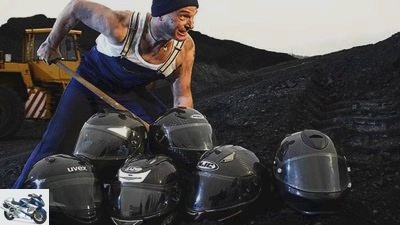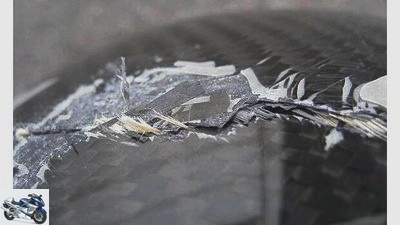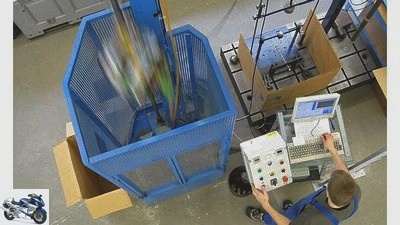Table of contents
- test Carbon helmets
- Shock absorbers
- Criteria and Results
- Conclusion
- BMW SportIntegral Carbon
- HJC HQ-1 carbon
- Lazer Fiber Pro Carbon Light
- Probiker Fiber Wing Carbon
- Probiker RSX II Carbon
- Schuberth S1 Carbon
- Uvex Helix RS 750 Carbon

Hertneck
clothing
Helmets
Motorcycle helmets made of carbon in the test
test
Carbon helmets
Without coal there is no carbon – this is true at least for some specimens in a double sense. Because if you opt for a motorcycle helmet with a carbon outer shell, in extreme cases you will be asked to pay almost 1500 euros. In a large laboratory and practical test of all currently available full-face helmet models with carbon covers, MOTORRAD clarifies whether the issue is worthwhile.
Holger Hertneck
11/22/2007
First things first: no carbon helmet is made of pure carbon. Under the carbon mats, which are visible from the outside, there are basically several layers of GRP and / or Kevlar fabric. This is the only way to meet the requirements for elasticity, hardness and resistance with regard to shock absorption tests according to ECE. Pure carbon would be too hard on the one hand, and too brittle on the other. These properties are also influenced by the type of production. Depending on how the carbon mats are aligned and how much resin is added during the manufacturing process.
In addition, not all helmets are manufactured in the extremely complex and expensive autoclave system in a vacuum furnace, which is supposed to ensure the lowest possible weight and maximum stability. That is only for the helmet outer shells from BMW and Schuberth the case. However, the manufacturing process is irrelevant for the result of the MOTORRAD test. The actual properties of the helmets, which result from the laboratory tests and from the results collected in practice, are decisive.
First of all, TuV Rheinland subjected all candidates to a shock absorption test in which 20 points out of a total of 100 points could be achieved. During the driving tests, the MOTORRAD testers checked and rated all criteria relevant to practice.
Buy complete article

test
Carbon helmets
6 pages) as PDF
€ 2.00
Buy now
Shock absorbers

archive
Torn carbon outer shell after shock absorption with visible GRP fibers.
MOTORRAD checked the important test criterion shock absorption in cooperation with the experts from TuV Rheinland in Cologne.
All tested helmets are tested according to ECE-R 22.05, have a corresponding sticker on the chin strap and should therefore have no problems passing the shock absorption test at TuV Rheinland.
In consultation with the TuV experts, MOTORRAD decided in favor of the particularly critical temperature range of minus 20 degrees Celsius and the flat anvil, which the candidates hit at a speed of 7.5 m / s (for the chin part 5.5 m / s). s) bounce. According to the ECE standard, tests are also carried out at plus 50 degrees Celsius with an edge anvil. The accelerations occurring in the test (limit value according to ECE: 275 g) are recorded by sensors in a probe in the helmet and forwarded to the computer. From the course of the acceleration, it calculates the HIC value (Head Injury Criterion; limit value 2400) relevant to the extent of the expected traumatic brain injury..
A total of four test persons exceeded the limit values, which astonishingly included the most expensive helmet by far, the BMW. Its score in the shock absorption criterion is correspondingly poor. Excellent, however: the cutting of the Uvex helmet. The results are also commendable Probiker Fiber Wing Carbon and the Schuberth S1 Carbon.
Criteria and Results

archive
The important test criterion shock absorption is checked by MOTORRAD in cooperation with the experts from TuV Rheinland in Cologne.
Fit / wearing behavior (20 points): ideal if the helmet sits securely and tightly at all speeds and neither annoys with pressure points nor slips when turning the head. The BMW model performed best in this regard.
Aerodynamics (10 points): The lower the drag and lift forces when driving straight ahead and looking over the shoulder, the higher the number of points achieved. Mainly because of its low neck forces when turning the head, this is where the Uvex front.
Acoustics (10 points): An open helmet base, an angular outer shell, protruding visors and protruding ventilation slides cause noise when driving. Schuberth offers by far the quietest head protection – but at the expense of a narrow entry.
Ventilation (10 points): Ventilation devices that are clearly noticeable and can be safely operated even with gloves are unfortunately the exception. What use is a neatly drilled helmet shell, for example, if, as with the Probiker Fiber Wing, an incorrectly placed inner lining prevents the air from flowing into the scalp? The best candidate here too: Schuberth.
Handling (10 points): How comfortable is the helmet to put on and take off? Does the closure work smoothly? How easy is it to operate and change the visor??
The test persons were able to collect additional points in the criteria equipment / workmanship (10 points) and weight (10 points). Commendable: Even the heaviest carbon helmets in the test are significantly lighter than comparable models with a GRP or polycarbonate outer shell. And that is the greatest advantage of the noble material – which usually also costs a lot of coal.
Conclusion
As usual, none of the test candidates get away with criticism. The Schuberth S1 Carbon earned the most points and thus the test victory. Just behind, but not even half as expensive and therefore the best buy: the Uvex model. It is incomprehensible that the most expensive helmet by far, the BMW, has major problems with shock absorption. Although it also gives away valuable points due to the non-closable head ventilation and an impractical visor mechanism, the outstanding wearing behavior and the sensationally low weight of well under 1000 grams still secure it the rating “good”. The performance of the cheapest helmet, the Probiker Fiber Wing with its unusually large checkered carbon mats, is praiseworthy, given the poor ventilation and a fogging visor “Good” costs.
BMW SportIntegral Carbon
Provider: BMW, phone 0180/5001972, www.bmw-motorrad.de; Price: 1495 euros; Sizes: 54/55 to 61; Color: carbon
Plus:
Perfect fit and excellent wearing behavior; very good guidance in the cheek area; lies very well in the wind when driving straight ahead; pleasantly quiet; well noticeable ventilation; excellently processed; sensationally light
Minus:
Big weaknesses in shock absorption; high cheek pads restrict the field of vision to the side; noticeably increasing air resistance when turning the head; Head ventilation cannot be closed; complex visor change; no visor catches; Visor not completely fog-free
Conclusion:
The currently lightest carbon helmet on the market is also by far the most expensive. The joy in the excellent wearing behavior tarnishes the poor result in shock absorption. BMW should definitely improve this and the visor technology on the SportIntegral Carbon.
Verdict: good
HJC HQ-1 carbon
Providers: HJC Europe Germany, phone 02131/523560, www.hjc-germany.de; Price: from 399.99 euros; Sizes: XS to XXL; Colors: carbon; from 2008 two decors (from 499.99 euros)
Plus:
Good wearing behavior; is neutral in the wind ?? also when turning the head; Ventilation buttons easy to use; perfect visor change mechanism; Visor lock; absolutely fog-free visor; very well processed; Large, attachable breathing mask for winter and race track use included
Minus:
Slight weakness in shock absorption; lies unevenly on the cheeks and in the area of the ears; loud, especially when turning the head; Drafts on the back of the head and ears
Conclusion:
The very well made and well equipped HQ-1 Carbon shines with the best handling in comparison, not least because of the impeccable visor mechanism. There are deductions for the poor acoustics (the helmet is comparatively loud), the only moderate ventilation and the weakness in the shock absorption test.
Verdict: Satisfactory
Lazer Fiber Pro Carbon Light
Provider: Buse, Telephone 02471/12690, www.buese.com; Price: 299.95 euros; Sizes: XS to XL; Color: carbon
Plus:
Is it neutral in the wind? also when turning the head; Ventilation buttons easy to use; absolutely fog-free Pinlock visor; well processed
Minus:
Big weaknesses in shock absorption; only moderate fit; poor guidance in the lower helmet area; very loud; Ventilation almost ineffective; when turning the head, drafts in the field of vision; Double-D fastener with stiff chinstrap; Edge areas and wind separation edges of the outer shell are not completely filled with carbon mats, but rather filled with resin
Conclusion:
On the outside it leaves behind Lazer a clean impression, which confirms the decent aerodynamics and handling. Significant weaknesses in shock absorption and wearing behavior, however, tarnish the picture. The comparatively low purchase price of the carbon light equipped with a flawless Pinlock visor is of no use either.
Verdict: Sufficient
Probiker Fiber Wing Carbon
Provider: Louis, Telephone 040/73419360, www.louis.de; Price: 199.95 euros; Sizes: XS to XL; Color: carbon
Plus:
Very good shock absorption values; good aerodynamics with low forces even when turning the head
Minus:
A bit loud; Ventilation almost ineffective; Chin ventilation very difficult to use with gloves; Drafts in the area of the ears; Visor fogged up; only moderately equipped and processed; Not very high quality processed recesses on the attached back of the head spoiler
Conclusion:
As far as the laboratory values for shock absorption are concerned, the cheapest test candidate in the field is one of the best test subjects, proving that it has the potential for a good helmet. However, the practicality lags behind. There is a lot to be improved, especially with regard to the visor and ventilation.
Verdict: satisfactory
Probiker RSX II Carbon
Provider: Louis, Telephone 040/73419360, www.louis.de; Price: from 229.95 euros; Sizes: XS to XL; Colors: carbon; Decor in three color variants (249.95 euros each)
Plus:
Good, pressure point-free fit and good wearing behavior; is neutral in the wind ?? even when turning your head
Minus:
Worst candidate in the test for shock absorption; Hardly noticeable ventilation; stiff ventilation buttons; noisy; Double-D fastener with poorly running chinstrap; Visor fogged up; Visor change possible without tools, but very stiff
Conclusion:
The RSX II Carbon cannot convince despite its good wearing behavior and good handling. Blatant weaknesses in the shock absorption as well as deficiencies in the equipment, the workmanship and the ventilation give the second cheapest candidate in the field the last place.
Verdict: Inadequate
Schuberth S1 Carbon
Provider: Schuberth, Telephone 0531/380050, www.schuberth.de; Price: 1050 euros; Sizes: 52/53 to 62/63; Color: carbon
Plus:
Very good shock absorption values; very good wearing behavior; particularly large field of vision; lies very well in the wind when driving straight ahead; very quiet; excellent ventilation; Ventilation buttons are very easy to use; absolutely fog-free visor; integrated sun visor; large reflective material; excellently processed
Minus:
Cheek pads a little too soft, therefore only moderate guidance when turning the head at high speeds; very narrow entry and exit; noticeably increase – the air resistance when turning your head
Conclusion:
Only a few minor flaws tarnish the excellent overall impression of the S1 Carbon, which despite the integrated sun visor and the most elaborate helmet interior? which ensures excellent noise levels? is amazingly easy. A well-deserved test winner due to the good shock absorption values, albeit at a proud price.
Verdict: VERY GOOD
Uvex Helix RS 750 Carbon
Provider: Uvex, Telephone 0911/97740, www.uvex-sports.de; Price: from 479.95 euros; Sizes: XS to XL; Colors: carbon; Decor in blue / white / silver and red / white / silver (499.95 euros each)
Plus:
Excellent shock absorption values; good wearing behavior; top aerodynamics with very low forces even when turning your head; relatively quiet; effective ventilation; Ventilation buttons easy to use; absolutely fog-free visor; well processed
Minus:
Very high cheek pads restrict the view to the side; very hard in the forehead area; Double-D fastener with stiff chinstrap because it is too wide; sharp-edged visor rim
Conclusion:
The Helix RS 750 Carbon with the best result in this criterion shows very impressively that even very light helmets can easily overcome the hurdles of ECE shock absorption. In terms of aerodynamics, too, the Uvex is at the forefront with its smooth exterior design. The few minor weaknesses do not change the fact that it is only half as expensive as the test winner.
Verdict: GOOD
Related articles
-
Motorcycle helmets for the racetrack in a comparison test
PHOTO-BK.COM 23 pictures PHOTO-BK.COM 1/23 In the comparison test, eleven racing helmets faced each other. mps photo studio 2/23 Simple but very…
-
Flip-up motorcycle helmets in the test
Horny clothing Helmets Flip-up motorcycle helmets in the test Product test flip-up helmets Motorcycle helmets that can be opened up in comparison What…
-
Motorcycle helmets: test, purchase advice, ECE standard, communication
Herder 14th pictures Herder 1/14 Jorg Lohse trying in vain to mount a wind deflector on the X-lite. Can you test harder? no! Herder 2/14 The Schuberth S1…
-
Motorcycle helmets for sports riders in the test
2Snap clothing Helmets Motorcycle helmets for sports riders in the test Product test: racing helmets Motorcycle helmets for sports riders in the test…
-
Flip-up motorcycle helmets between 139 and 649 euros in the test
Photo: mps-Studio 12th pictures mps studio 1/12 12th place: LZR MH2, from 139 euros, 52/100 points, MOTORRAD judgment “sufficient” mps studio 2/12 9th…
-
4 carbon motorcycle helmets in the product test
mps photo studio clothing Helmets 4 carbon motorcycle helmets in the product test 4 motorcycle carbon helmets tested Noble full-face helmets in the…
-
16 flip-up motorcycle helmets in a comparison test
2snap 57 pictures mps photo studio 1/57 Rather unusual: the chin section can be swiveled backwards, … mps photo studio 2/57 The opener on the chin part…
-
14 sporty full-face motorcycle helmets in a comparison test
Klaus Herder 50 pictures Klaus Herder 1/50 mps photo studio 2/50 Visor without detent and with locking in the field of vision. mps photo studio 3/50…
-
Comparison test flip-up helmets
Bilski clothing Helmets Comparison test flip-up helmets Comparison test flip-up helmets Open air performance The popularity of flip-up helmets is…
-
Product test full-face helmets with integrated sun visor
mps photo studio clothing Helmets Product test full-face helmets with integrated sun visor Product test full-face helmets with integrated sun visor…